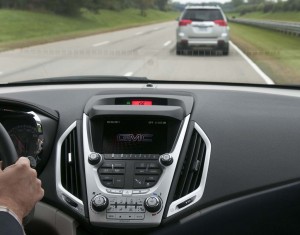
Collision avoidance systems improve safety for individual vehicles, but potential new rules might use similar technology to make roads safer for all.
Black boxes in vehicles already track a variety of bits of information that is used by safety officials, automakers and others to determine what a car or truck does after it does it. However, the Obama administration is looking to use that information in real time to save more than 1,000 lives annually.
Using vehicle-to-vehicle (V2V) technology that allows vehicles to talk to one another and warn drivers of a potential collision could save an estimated 1,083 lives prevent 592,000 crashes annually, according to a report from the National Highway Traffic Safety Administration (NHTSA).
Using V2V technology could provide drivers an advanced warning of a possible accident Left Turn Assist (LTA) and Intersection Movement Assist (IMA) scenarios. The systems use radio waves to send out signals that are received and interpreted by other vehicles. Depending upon the data sent, the systems could provide drivers with warnings.
LTA warns drivers not to turn left in front of another vehicle traveling in the opposite direction and IMA warns them if it is not safe to enter an intersection due to a high probability of colliding with one or more vehicles.
The technology is not limited to just vehicles. The systems are adaptable and can be used to create larger networks by installing them in traffic lights, signs, buildings and other fixed edifices to collect and transmit data. That information could then be fed into the network to expand its such as forward collision, blind spot, do not pass, and stop light/stop sign warnings.
While much of this technology is readily available on vehicles right now, it’s limited. The technology isn’t interactive with other vehicles, i.e. adaptive cruise control reads other vehicles and adjusts the speed of just one car, not other cars. Also, it’s generally available only on higher priced luxury or sport-luxury vehicles.
“Safety is our top priority, and V2V technology represents the next great advance in saving lives,” said U.S. Transportation Secretary Anthony Foxx in a statement. “This technology could move us from helping people survive crashes to helping them avoid crashes altogether – saving lives, saving money and even saving fuel thanks to the widespread benefits it offers.”
(Continental ups the autonomous car ante. For more, Click Here.)
What the technology does not do is make a regular vehicle a self-driving or autonomous car. It’s aimed at providing feedback to drivers. However, it could be used in concert with those vehicles to make the roads safer, according to NHTSA.
(Click Here for more about Reid Bigland taking charge of Alfa Romeo.)
“By warning drivers of imminent danger, V2V technology has the potential to dramatically improve highway safety,” said NHTSA Deputy Administrator David Friedman. “V2V technology is ready to move toward implementation and this report highlights the work NHTSA and DOT are doing to bring this technology and its great safety benefits into the nation’s light vehicle fleet.”
(To get details about Cadillac’s plans to enter the small luxury car segment, Click Here.)
The agency is gathering feedback on the proposed plan from the public as well as automakers, suppliers, advocacy organizations and others. The intent is to deliver a Notice of Proposed Rulemaking by 2016.
